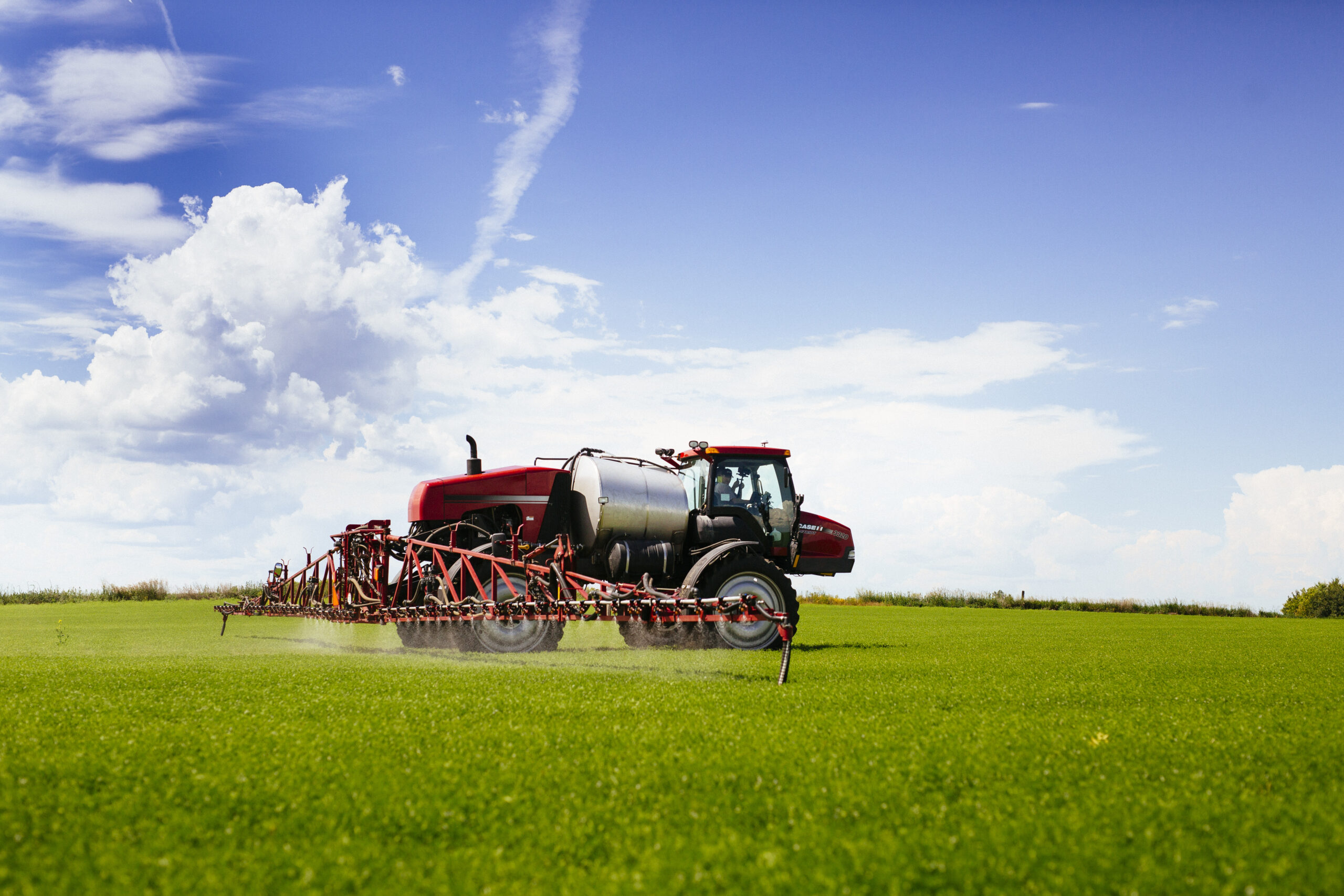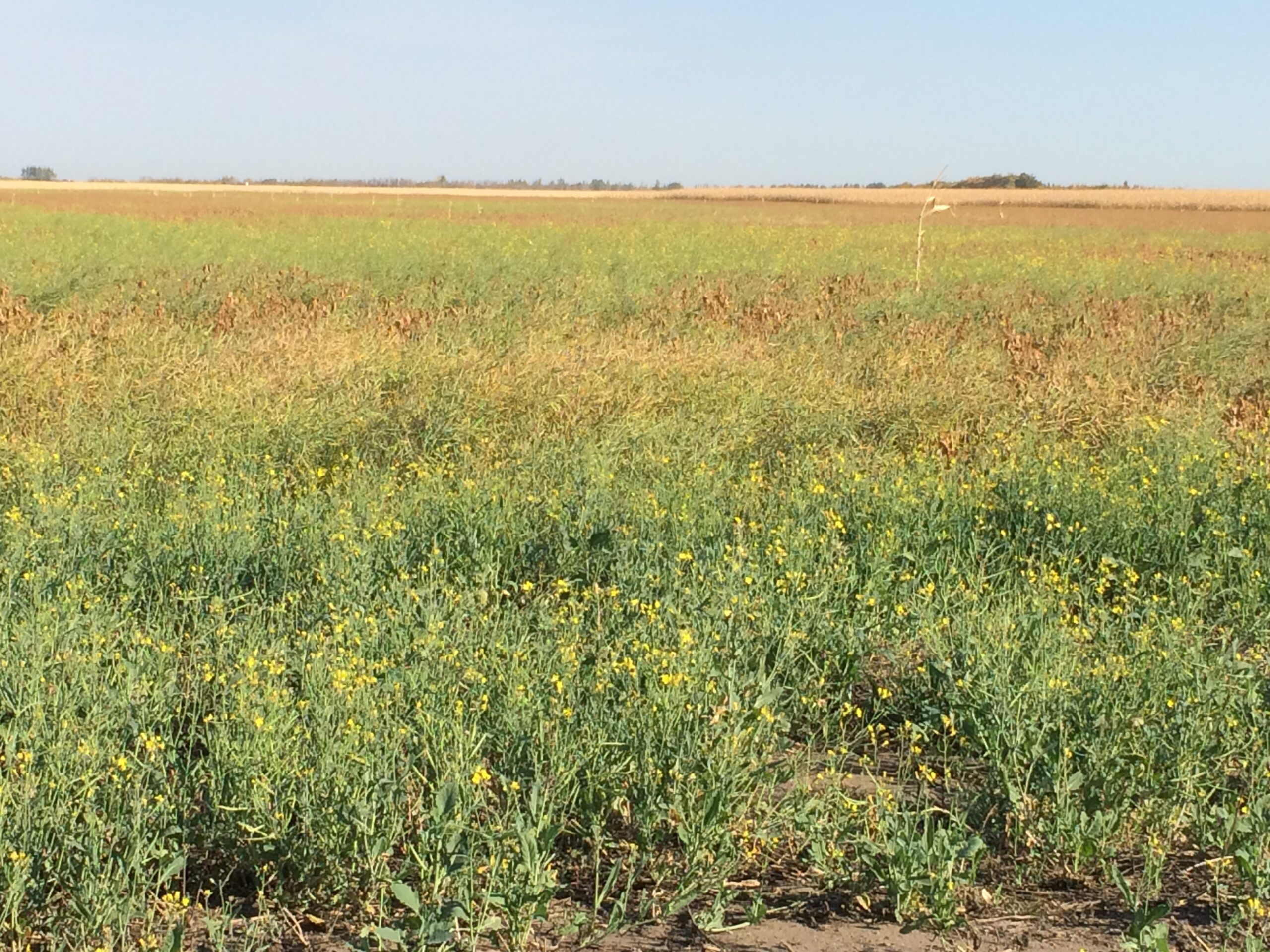Managing Group 2-Resistant Stinkweed in Peas & Lentils
By Paige Kennedy, BSc.Agr., AAg
Background
Prairie pulse growers face many challenges, not the least of which is managing herbicide-resistant weeds. According to Prairie Weed Survey data, herbicide-resistant weed biotypes have increased significantly in the last few decades across the Canadian Prairies. Compared to the 2014 survey, results from the 2019 survey showed increased abundance of resistant wild oats, kochia, foxtail barley, cleavers, and stinkweed, among many others.
Stinkweed (Thlaspi arvense), also known as field pennycress, is a winter annual broadleaf weed that is becoming increasingly herbicide- resistant in the Prairies. Stinkweed is a member of the mustard family (Brassicaceae) and can be identified by its hairless leaves and stems, and its basal seedling rosette with slightly toothed leaf margins in the early stages of growth (Figures 1, 2, and 3). As the plant matures in late spring, small white flowers (3 mm) form (Figure 4). Stinkweed reproduces solely through seeds, formed in large flat seedpods called silicles (8–12 mm) that branch off the main stems (Figure 5). The name ‘stinkweed’ is attributed to the tell-tale sour turnip or garlic odor the plant emits – a feature that can also help growers to distinguish it from similar looking weed species, especially in the earlier growth stages where misidentification is common.

Source: Government of Manitoba Agriculture

Source: Government of Manitoba Agriculture

Source: Iowa State University Extension & Outreach

Source: The Western Producer

Source: Sylvite
Stinkweed typically germinates in the late summer or early fall and overwinters as a seedling before becoming fully established early the following spring. Seedlings will flower within 30–50 days of emergence or spring germination. This early establishment allows stinkweed, like other winter annuals, to compete for spring moisture and outgrow in-crop herbicide application windows. Stinkweed is both drought- and frost-tolerant and produces up to 15,000 seeds per year from a single plant. These seeds have thick protective seed coats that enable them to survive for up to six years in the tillage zone. Seeds buried deeper in the soil can survive up to 20 years and initiate germination when they come near the soil surface and conditions are favourable.
Stinkweed is a common weed in Saskatchewan fields and is of growing concern for Prairie pulse growers. In fact, this species has found itself in the top 15 most abundant weeds list in the last three Prairie weed surveys. Prolific seed production, overwinter seedling establishment, competitive early-season advantage, and especially limited herbicide control options make stinkweed a weed to watch.
Managing Stinkweed: Herbicide Resistance
One of the main challenges with stinkweed management is its seasonal growth pattern wherein the plant is already well-established by early spring, often before farmers can even get into their fields. As such, catching the weed before it grows beyond what herbicide labels can control is a common issue. This leads to sub-lethal applications of herbicide actives contributing to the increased development of herbicide resistance in stinkweed.
Overall abundance of stinkweed, as well as its resistance to Group 2 herbicides, has risen concerningly over the past number of years. 15% of stinkweed samples analyzed from Saskatchewan and Alberta in the Prairie Weed Survey were found to be resistant to Group 2 herbicides. Herbicide resistant biotypes were originally found in earlier Saskatchewan weed surveys (2007–2011) with these populations continuing to rise according to recent data from the 2019 and 2021 weed reports.
Like other Group 2-resistant weeds, there are two main types of herbicide resistance mechanisms that are pertinent to stinkweed: target site resistance and non-target site resistance (enhanced metabolism and gene stacking). In relation to Group 2 herbicides, acetolactate synthase (ALS) inhibitors, target site resistance occurs when there is a point mutation on the ALS enzyme in the plant, which Group 2 herbicides bind to, causing plant death. When the enzyme mutates, the herbicide’s target is no longer the same and the plant is much more resistant to that mode of action. These point mutations happen randomly, but when they lead the plant to be more successful by improving survivability, such as mutations on the ALS enzyme, the plant can mature and set seed. Progeny from the plant will also survive due to the mutation, and herbicide resistant populations increase. Because of this, target site resistance can happen relatively quickly in a plant population.
In contrast, enhanced metabolism is a non-target site resistance mechanism that tends to occur more slowly and can impact the efficacy of herbicides across a range of groups at the same time (not only Group 2). Genetic changes randomly occur that improve plant survivability, and these changes continue over time to further improve the success (i.e. resistance) of the plant species against herbicide control. Plants degrade the herbicide into less toxic metabolites as the active is on its way to the target site. By the time the herbicide reaches the target, the plant can digest the toxin and survive the application. The rate the plant can survive increases over time as genetic changes continue to occur. Metabolic resistance is caused by practices including sub-lethal herbicide application rates or applying herbicides past the recommended application timing. Another non-target site resistance mechanism that we see in stinkweed is gene stacking. In this mechanism, weeds cross-pollinate, and their progeny have the potential to possess herbicide resistance of both parent plants. This is called stacked herbicide resistant genes. In this way, progeny may possess both target and non-target site herbicide resistance traits and can be resistant to herbicide application entirely.
Peas & Lentils
Peas and lentils are especially poor competitors against weeds, which have the potential to reduce yields significantly (20–40%). In lentils, the thin crop canopy and short growth height pose an issue not only for weeds, but also makes harvest more challenging as both weeds and the crop grow close to the ground. Peas and lentils are both sensitive to many herbicides up to two years post-application, limiting chemical control options in pea and lentil rotations. Additionally, the critical weed-free period for lentils is between the two-to-five node stage while in-crop herbicides should be applied in both peas and lentils between two-to-six nodes. This leaves a tight two-week window for herbicide application to occur. As a producer, it is important to maintain detailed field records which include herbicide applications and residual periods, as well as field weed histories. Using Group 1 and Group 2 herbicides in non-lentil or pea years may be a good option for producers who employ longer rotations.
In 2022, Saskatchewan growers seeded 3.7 million acres of lentils and 1.8 million acres of peas. Of the chemical control options available for stinkweed management in pea and lentil acres, the only in-crop options currently available to growers are Group 2 actives imazamox, imazamethabenz, and imazamethapyr, (trade names Odyssey®, Pursuit®, Solo®, or Viper®), or Group 5 metribuzin (trade name Sencor®). As Group 2 herbicide resistance climbs in stinkweed, the options for effective weed control will continue to dwindle. With a small pool of herbicide options made smaller by herbicide-resistant weeds, chemical control of weeds in pulses is a real challenge and poses serious risks to production and profitability for pea and lentil growers in Western Canada.
Management Options
While most in-crop herbicide options for broadleaf weed control in peas and lentils rely on Group 2 herbicide actives, there are several pre-emergent and post-harvest control options from different modes of action that can be used to control Group 2-resistant stinkweed biotypes. For example, control of stinkweed rosettes is of high importance in the fall and early control can mitigate yield losses later. Stinkweed rosettes allowed to over-winter become strong competitors the following spring. This is because stinkweed seedlings, which started to establish themselves before winter, have a head start over spring-planted crops and can claim a great deal of soil moisture and nutrients before spring seeding can even occur. Stinkweed plants that escape tillage or spring weed control treatments are usually too mature for control with in-crop herbicide applications. Escapes will likely need to be managed manually, through pulling or mowing. As usual, best management practices for weed control include chemical, mechanical, and cultural practices. Farmers who are dealing with Group 2 herbicide-resistant stinkweed may consider one or more combinations of the following control options:
- Control fall rosettes to limit seed production the following spring and reduce the contribution to the weed seed bank.
- Prioritize pre-seed or pre-emergent herbicide applications, including glyphosate tank mixes, when stinkweed rosettes are small, certainly prior to stem bolting and flowering. In-crop herbicides will only provide good control for spring germinated stinkweed; plants that have bolted will not receive good control with this method.
- Implement crop rotation practices (ideally four-year rotations) to vary herbicide groups used and break up application patterns.
- Avoid using the resisted mode of action on fields with confirmed or suspected resistance – it is advised to switch to a different mode of action entirely (i.e. if there is confirmed Group 2-resistant stinkweed in the field, avoid using Group 2 herbicides).
- Increase or maintain high seeding rates to improve plant populations and competitiveness of the cultivated crop.
- Inoculate, fertilize (where needed), and apply a compatible seed treatment to encourage early germination and crop establishment, especially in cool early spring conditions.
- Tillage may be an option, however it is not especially effective at controlling stinkweed and is detrimental to the soil, so tillage activities should be reserved as a last resort. In conventional tillage systems, plants with developed pods should not be turned under as they can continue to ripen on stalks in warm soil.
- Post-emergent harrowing has been somewhat successful in controlling weeds in peas, but growers should increase their seeding rates to account for plant losses as a result.
- Refrain from grazing or feeding to livestock, like cattle, as stinkweed can taint milk and meat and can become toxic to animals at high concentrations.
Future Options for Managing Group 2 Resistance
In the 2019 Prairie weed survey, it was revealed that a novel stinkweed biotype resistant to Group 2 herbicides was discovered in samples taken throughout Saskatchewan and Alberta. This should serve as a reminder to growers to be diligent with their best weed management practices to delay further development of herbicide resistance. As with other herbicide-resistant weeds, the development of a new mode of action would likely provide the best chemical control option. However, producers are warned not to hope on a silver bullet to come to the rescue. Good, conscientious agronomic management practices are farmers’ best bet for controlling herbicide-resistant stinkweed.
Cultural control methods such as intercropping, cover cropping, and increasing rotational crop diversity may also help to alleviate some selection pressure and break up growth patterns. Right now, delaying herbicide resistance development and keeping resistance to minimal herbicide groups is of high priority when considering the future of stinkweed management.
Additionally, research efforts have evaluated the potential of breeding stinkweed into a cultivated crop due to its high oilseed content. Interestingly, some research has also been done on the potential viability of using stinkweed as biofuel. Until then, growers are encouraged to keep up-to-date on herbicide-resistant weed research and continue to employ best management practices to control weeds and delay herbicide resistance development.


